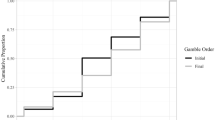Abstract
This article reports 15 first-price auction experiments, each with four bidders, designed to test Cedric Smith' (1961) hypothesis that risk-neutral behavior can be induced in subjects' decisions by paying them in lotteries on money that are linear in the outcome probabilities. We choose the first-price auction environment because of its relatively high success in surviving a large number of tests, which contrasts with the widely documented tendency of subjects to violate the expected utility axioms in making choices among gambles. In the first five experiments, subjects were experienced in first-price auctions with monetary rewards. We prescreened these subjects for exceptionally high bidding consistency with the constant relative risk-averse model. The results unyielded only weak support for the risk-neutralizing procedure (3 of 10 risk-averse cases became risk-neutral, but only 1 in 8 that were retested continued to exhibit risk-neutral behavior). We recruited 16 new subjects with no previous experience for four lottery-only auctions. Eight of the 16 subjects bid as if risk-neutral, but in a retest of 12 subjects only 2 remained consistently risk-neutralized. Finally we recruited 12 inexperienced subjects, and each subject bid against 3 robot bidders whose bidding strategies were known to the human bidder. We use this procedure to control for Nash expectations. These 12 subjects were run under both monetary and lottery reward conditions. Two of the 12 subjects bid as if risk-neutral in the lottery auction, but both of these subjects had shown risk-neutral behavior with monetary rewards. In conclusion, we find very weak support for the risk-neutralizing procedure. We caution other researchers to run calibration tests of the procedure in the particular context they are studying to assess its reliability.
Similar content being viewed by others
References
BeckerGordon M., Morris H.Degroot, and JacobMarschak. (1964). “Measuring Utility by a Single-Response Sequential Method,“ Behavioral Science 9, 226–232.
BergJoyce E., Lane A.Daley, John W.Dickhaut, and John R.O'Brien. (1986). “Controlling Preferences For L Lotteries On Units of Experimental Exchange,” Quarterly Journal of Economics 101 (2), 281–306.
CoxJames C., Vernon L.Smith, and James M.Walker. (1985a). “Expected Revenue in Discriminative and Uniform Price Sealed Bid Auctions.” In Vernon L.Smith (ed.), Research in Experimental Economics, vol. 3, Greenwich: JAI Press, pp. 183–232.
CoxJames C., Vernon L.Smith, and James M.Walker. (1985b). “Experimental Development of Sealed Bid Auction Theory: Calibrating Controls for Risk Aversion,” American Economic Review 75, 160–165.
CoxJames C., Vernon L.Smith, and James M.Walker. (1988). “Theory and Individual Behavior of First-Price Auctions,” Journal of Risk and Uncertainty 1, 61–99.
Radner, Roy, and Andrew Schotter. (1987). “The Sealed Bid Mechanism: An Experimental Study,” Discussion paper, February. Forthcoming in Journal of Economic Theory.
RothAlvin E. (1987). “Bargaining Phenomena and Bargaining Theory.” In Alvin E.Roth (ed.), Laboratory Experimentation in Economics: Six Points of View. New York: Cambridge University Press.
RothAlvin E., and Michael W. K.Malouf. (1979). “Game-theoretic Models and the Role of Information in Bargaining,” Psychological Review 86, 574–594.
RothAlvin E., and J. KeithMurninghan. (1982). “The Role of Information in Bargaining: An Experimental Study,” Econometrica 50, 1123–1142.
RothAlvin E., and FrancoiseSchoumaker. (1983). “Expectations and Reputations in Bargaining: An Experimental Study,” American Economic Reivew 73, 362–372.
SmithCedric A. B. (1961). “Consistency in Statistical Inference and Decisions,” Journal of the Royal Statistical Society, Ser. B, 23, 1–25.
VickreyWilliam. (1961). “Counterspeculation, Auctions, and Competitive Sealed Tenders,” Journal of Finance 16, 8–37.
WalkerJames M., Vernon L.Smith, and James C.Cox (1987). “Bidding Behavior in First Price Sealed Bid Auctions: Use of Computerized Nash Competitors,” Economics Letters 23, 239–244.
Author information
Authors and Affiliations
Rights and permissions
About this article
Cite this article
Walker, J.M., Smith, V.L. & Cox, J.C. Inducing risk-neutral preferences: An examination in a controlled market environment. J Risk Uncertainty 3, 5–24 (1990). https://doi.org/10.1007/BF00213258
Issue Date:
DOI: https://doi.org/10.1007/BF00213258




